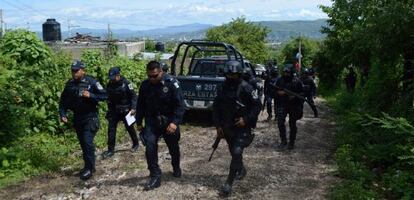Bodies found outside Iguala not those of missing students, says prosecutor
Mexican authorities still looking for 43 youths who disappeared after their September arrest


There are corpses, there are burial pits, there are murderers, but nothing makes any sense.
The investigation into the disappearance of 43 college students in Iguala reached new heights of confusion on Tuesday when Mexico's Attorney General, Jesús Murillo Karam, stated that the 28 charred bodies found outside town are not those of the missing youths.
“I can tell you that the first mass graves that were found, the very first that we have some results from, do not match the DNA of [missing students’] relatives,” said Karam.
The announcement raises new questions in a complex case, where, despite a 19-day investigation and around 50 arrests, the whereabouts of the missing students remains a mystery.
It also opens up a window of hope for the parents, who believe the teachers’ college students are being held by a local drug gang called Guerreros Unidos somewhere in the nearby mountains, despite the ongoing search by the army, the navy, the federal and state police and the intelligence services.
If so, it would be the longest mass abduction in recent Mexican history.
Another hypothesis, which investigators find more realistic, is that the students are dead and their bodies lying inside other graves that have been found but not opened yet.
The director of Mexico’s Criminal Investigation Agency, Tomás Zerón, said that a new clandestine grave has been found, although he did not provide any details about it. “There are bodies there, but they are still unidentified,” said an official source.
Testimony provided by two hitmen who confessed to killing 17 of the students on behalf of Iguala drug gang leaders seems to support this theory.
The hitmen who confessed to the killings did not provide clear clues as to where the bodies were buried
The problem, said sources familiar with the investigation, is that the murderers did not provide clear clues as to where the bodies were buried.
If the search is fruitless, then the story of the college students who disappeared after being arrested by Iguala police and being turned over to Guerreros Unidos will join that of all the other missing people in Mexico, of which there are more than 13,000 officially recognized cases.
These include the kidnapping in broad daylight of 300 people, including seniors, women and children, from the streets of Allende by a drug gang called Los Zetas. That was in March 2011. Three years later, nobody knows where they went, and the remains found in various unmarked graves have yet to be identified. The victims’ families still hope to find them alive one day.
Meanwhile, back in Iguala, all possibilities remain open. As do questions such as: if they are not the students, then who are the 28 people buried in a mass grave outside town?
Tu suscripción se está usando en otro dispositivo
¿Quieres añadir otro usuario a tu suscripción?
Si continúas leyendo en este dispositivo, no se podrá leer en el otro.
FlechaTu suscripción se está usando en otro dispositivo y solo puedes acceder a EL PAÍS desde un dispositivo a la vez.
Si quieres compartir tu cuenta, cambia tu suscripción a la modalidad Premium, así podrás añadir otro usuario. Cada uno accederá con su propia cuenta de email, lo que os permitirá personalizar vuestra experiencia en EL PAÍS.
¿Tienes una suscripción de empresa? Accede aquí para contratar más cuentas.
En el caso de no saber quién está usando tu cuenta, te recomendamos cambiar tu contraseña aquí.
Si decides continuar compartiendo tu cuenta, este mensaje se mostrará en tu dispositivo y en el de la otra persona que está usando tu cuenta de forma indefinida, afectando a tu experiencia de lectura. Puedes consultar aquí los términos y condiciones de la suscripción digital.
Archived In
Últimas noticias
The complicated life of Francesca Albanese: A rising figure in Italy but barred from every bank by Trump’s sanctions
Half of Scotland is in the hands of 420 property owners
Reinhard Genzel, Nobel laureate in physics: ‘One-minute videos will never give you the truth’
Pinochet’s victims grapple with José Antonio Kast’s rise in Chile
Most viewed
- Pablo Escobar’s hippos: A serious environmental problem, 40 years on
- Why we lost the habit of sleeping in two segments and how that changed our sense of time
- Charles Dubouloz, mountaineering star, retires at 36 with a farewell tour inspired by Walter Bonatti
- Reinhard Genzel, Nobel laureate in physics: ‘One-minute videos will never give you the truth’
- The Florida Keys tourist paradise is besieged by immigration agents: ‘We’ve never seen anything like this’








































